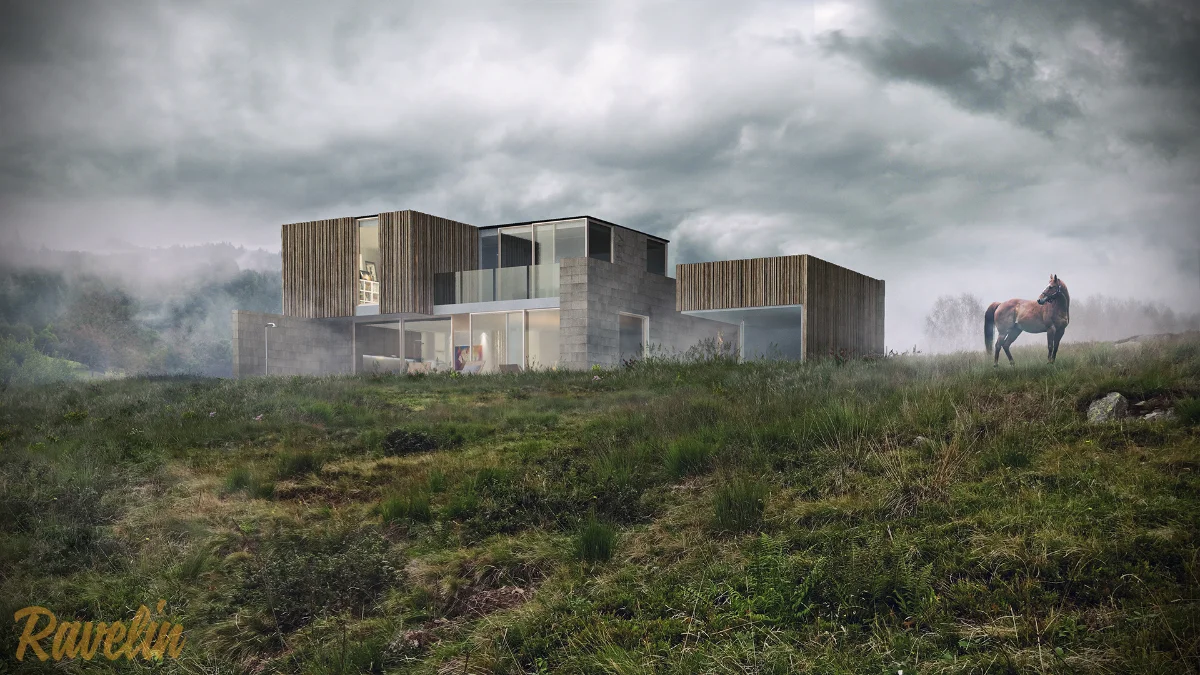How 3D Visualization Is Transforming Real Estate Marketing and Sales
Imagine trying to sell a dream without a picture. You've got blueprints, floor plans, maybe even a mood board — but for most buyers, that’s like handing them a puzzle with no image on the box. This is where 3D visualization steps in like a spotlight on a darkened stage — suddenly, the abstract becomes tangible, the vision becomes visible.
3D renderings give real estate professionals a superpower: the ability to show the future. Whether it’s a luxury condo still under construction or a dusty plot that will soon become a commercial center, rendering brings it to life before a single brick is laid.
Let’s unpack what exactly this means and why it’s revolutionizing the industry.
What Is 3D Architectural Rendering?
In simple terms, 3D rendering is the process of creating lifelike images of spaces that don’t yet exist. But in practice, it’s closer to storytelling. It’s a way to capture not just walls and windows, but atmosphere — golden hour light washing over a rooftop terrace, shadows falling across a polished marble floor.
It’s used by architects, developers, marketers, and realtors to turn imagination into something visually stunning — and more importantly, convincing.
Why Visualization Matters in Property Marketing
Let’s be honest: most people aren’t spatial thinkers. Hand them a floor plan, and they’ll nod while secretly wondering which end is the kitchen. But give them a photorealistic rendering, and they’ll start imagining birthday parties in the backyard or coffee by the window. It’s about emotional engagement — and emotions sell.
We live in a swipe-first world. If your listing doesn’t make a visual impact in the first three seconds, it’s gone. 3D renders grab attention, hold it, and tell a compelling story — all without saying a word.

Key Benefits of 3D Rendering for Real Estate Professionals
Accelerating the Sales Cycle
Selling property is a race against the clock — and 3D rendering is your secret shortcut. When you can show potential buyers exactly what they’re getting, before it's even built, you skip weeks (or months) of back-and-forth. No need to wait for site visits or construction milestones — a realistic visual can seal the deal from a laptop screen.
Developers are now pre-selling entire buildings based on high-end visualizations. Think about it: would you rather invest in an idea or something you can see?
Boosting Buyer Engagement and Emotional Response
A flat brochure doesn’t spark emotion. But a render of a sunlit living room overlooking the ocean? That gets hearts beating faster. 3D visuals allow buyers to connect emotionally — and that’s what drives decisions. The soft glow of evening lights, the texture of wood beneath imagined feet — buyers feel the space. That feeling turns into trust. And trust turns into contracts.
Enhancing Pre-Construction and Off-Plan Sales
Let’s say you're selling a high-rise that’s nothing but a construction site right now. Without 3D visuals, your only hope is abstract promises. With them, you're showing a finished lobby with marble floors and rooftop pools sparkling under sunset skies.
Off-plan sales are no longer a leap of faith — they’re a guided tour through the future.
Supporting Buyer and Investor Decision-Making
Investors want clarity. Homebuyers want comfort. City planners want accuracy. 3D renderings tick all those boxes. From design approval to investment pitch decks, they help decision-makers say “yes” with confidence. Complex projects suddenly become digestible. There’s less guesswork — and fewer surprises down the line.
Helping Justify Higher Asking Prices
Presentation affects perception. A luxury development shown through rough sketches might come across as just another project. But rendered with cinematic precision? Now it looks like it's worth the premium. Beautiful visuals build perceived value. And perceived value builds margins.
Reducing Miscommunication and Risk
No more “I thought the kitchen was bigger” or “I didn’t imagine the view like that.” With realistic renders, what buyers see is what they’ll get — and that clarity reduces misaligned expectations, change requests, and costly rework. In a way, 3D rendering isn’t just a marketing tool — it’s a form of insurance.

Marketing Advantages of 3D Visualization
Strengthening Online and Social Media Campaigns
In a world where clicks matter, visuals are king. Scroll-stopping renders turn passive browsers into curious buyers. Whether it's an Instagram reel or a Facebook ad, 3D content increases engagement and makes listings pop.
Improving Website Conversion and SEO
Renderings don’t just look good — they keep users on your site longer. That signals relevance to search engines. Add alt-text, fast loading, and a smart UX — and you’ve got an SEO asset that sells.
Creating Shareable and Attractive Visual Content
Renders are ready-made for sharing. From Pinterest boards to LinkedIn posts, they help realtors and developers build buzz around a property — even before the first nail is hammered.
Reinforcing Developer and Realtor Branding
Great visuals reflect a great brand. Consistent, polished renderings across your marketing channels show professionalism — and position your firm as premium.

Types of 3D Visual Content Used in Real Estate
Exterior Renderings
Daytime and Nighttime Views From bright facades under midday sun to moody twilight with glowing windows — lighting sets the tone and tells different stories. A simple shift from AM to PM can sell a whole new vibe.
Golden Hour and Seasonal Versions Want buyers to imagine summer barbecues or winter coziness? Renderings tailored to seasons create emotional hooks that static photos rarely deliver.

Interior Renderings
Residential Interiors From cozy studio layouts to luxury penthouses, interior renders help buyers see themselves living there — furniture, textures, and even lifestyle included.
Commercial Interiors Showcase flexible office layouts or retail atmospheres. Commercial clients want to know the space works — visuals answer that before the first viewing.

Aerial Views and Site Context
Bird’s-eye visuals help situate the property in its environment — highlighting location perks like parks, transport, or skyline views.

3D Floor Plans and Cutaways
These aren’t your old-school blueprints. A 3D floor plan shows flow, volume, and layout in a single glance. Buyers love them. Agents do too.

Virtual Tours and Interactive Walkthroughs
Why wait for an open house? Interactive tours let prospects explore on their terms — day or night, from across the world.
3D Animations and Promotional Videos
Add music, movement, voiceover — and suddenly, a building becomes a story. Perfect for campaigns and investor presentations.
Photomontages with Real Environment Backgrounds
Blend renders with drone shots or site photos to show exactly how the project fits into its future surroundings — reality meets imagination.

Improving Communication With Stakeholders
Visualizing Renovation Potential and Future Modifications
Need to pitch a renovation or rezoning? A rendering does what words can’t — it shows exactly how things will change. No guessing, no squinting at sketches.
Aligning Architects, Developers, and Marketing Teams
Everyone sees the same vision — literally. 3D visuals streamline collaboration, reduce confusion, and keep everyone moving in the same direction.
Gaining Faster Approvals From Clients and Authorities
When decision-makers can visualize outcomes, they approve faster. A clear picture removes friction, especially with permits or investor sign-offs.

Real Estate Use Cases and Success Stories
Residential Property Marketing
From suburban homes to downtown lofts, 3D renders help buyers fall in love before the site visit. They make even unfinished listings feel “move-in ready.”
Commercial and Mixed-Use Developments
Leasing offices, retail units, or restaurants? Renders showcase flexibility, tenant fit-outs, and future foot traffic — all in one image.
Investor and Stakeholder Presentations
Want to raise capital or pitch a new project? A slick visual story beats a spreadsheet any day. Investors buy clarity and confidence.
Tools for Real Estate Agencies and Brokers
Agencies use 3D visuals as sales tools — for listings, mailers, and listing presentations. It sets them apart in a crowded market.

Cost vs. Value: Why 3D Rendering Is a Smart Investment
More Affordable Than Traditional Photography
Think about the logistics: staging, lighting, travel, post-production. Now replace all that with a single render — faster, cleaner, cheaper.
Higher ROI Through Faster Sales and Reduced Rework
Quicker approvals, fewer change orders, shorter sales cycles — the compounding effect of visuals pays for itself. Often, many times over.
Scalability for Projects of Any Size
Whether you're marketing one unit or an entire masterplan, 3D rendering scales effortlessly. No limits — just possibilities.

Choosing the Right 3D Rendering Partner
What to Look for in a Visualization Studio
It’s not just about pretty pictures. Look for studios that understand architecture, marketing, and storytelling. You want strategy, not just style.
Importance of Realism and Technical Accuracy
That sunlight better fall where it would in real life. Shadows, materials, reflections — details matter when you're selling something that doesn’t exist yet.
Evaluating Portfolio and Industry Experience
Don’t just look at past work — look for relevance. Has the studio worked with real estate projects like yours? Do they understand your market?
Communication, Revisions, and Delivery Timelines
Speed matters. So does flexibility. A great team listens, revises quickly, and delivers on time — without endless hand-holding.

The Future of Real Estate Marketing With 3D Visualization
Integration With AR/VR Technologies
Imagine clients walking through a penthouse via VR — long before it's built. The line between digital and real estate is blurring fast.
AI-Driven Customization and Real-Time Design Changes
Buyers want control. AI and parametric tools let them tweak layouts, finishes, even furniture — all on the fly. Personalization sells.
Growth of Virtual Showrooms and Digital Twins
Sales offices are moving online. Digital twins — interactive, real-time 3D models — will soon be standard for developers and agents alike.
Conclusion
3D rendering is more than just a visual upgrade — it’s a new language for selling space, time, and possibility. In a fast-moving market, the developers, brokers, and marketers who adopt it early don’t just stay relevant — they lead.




